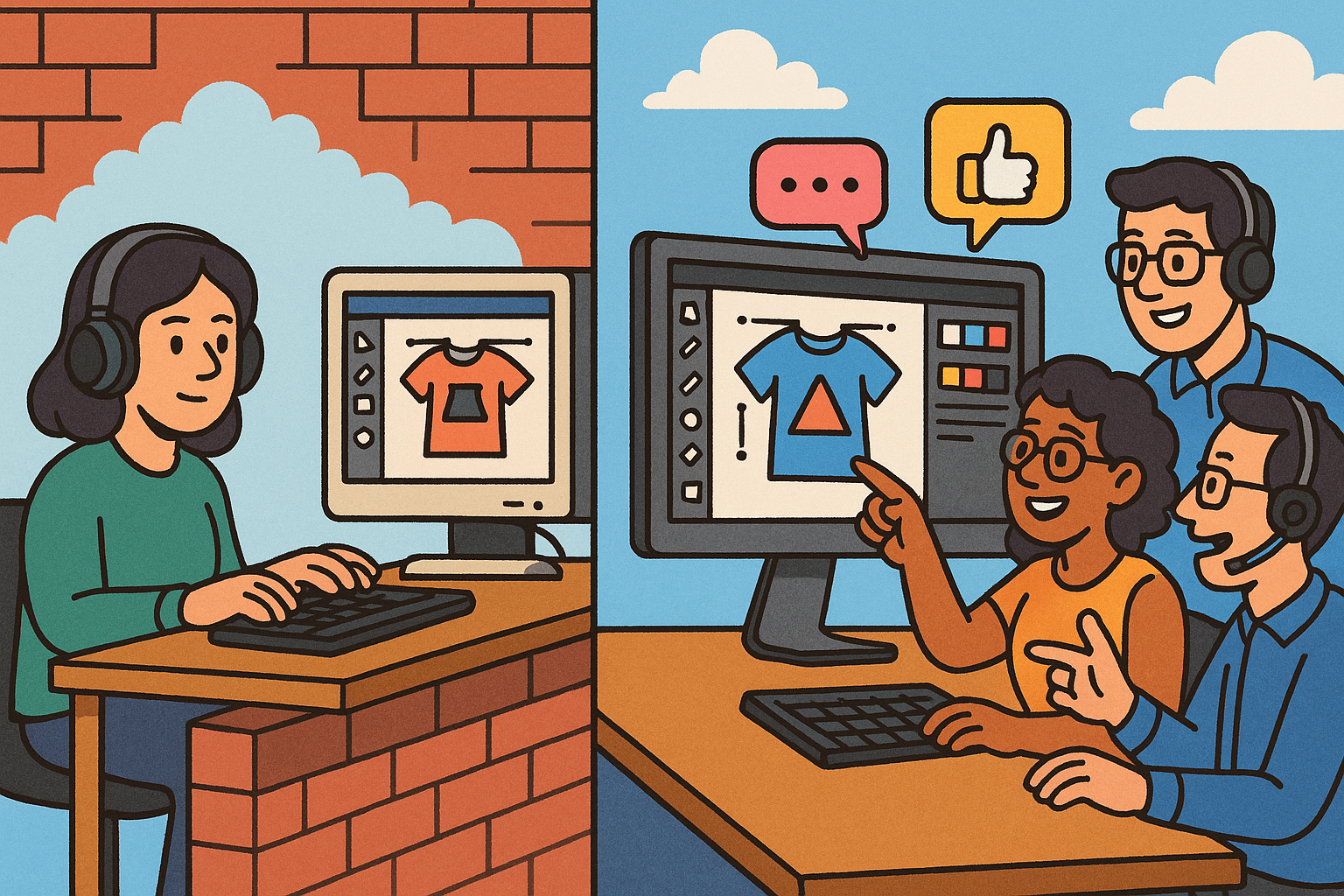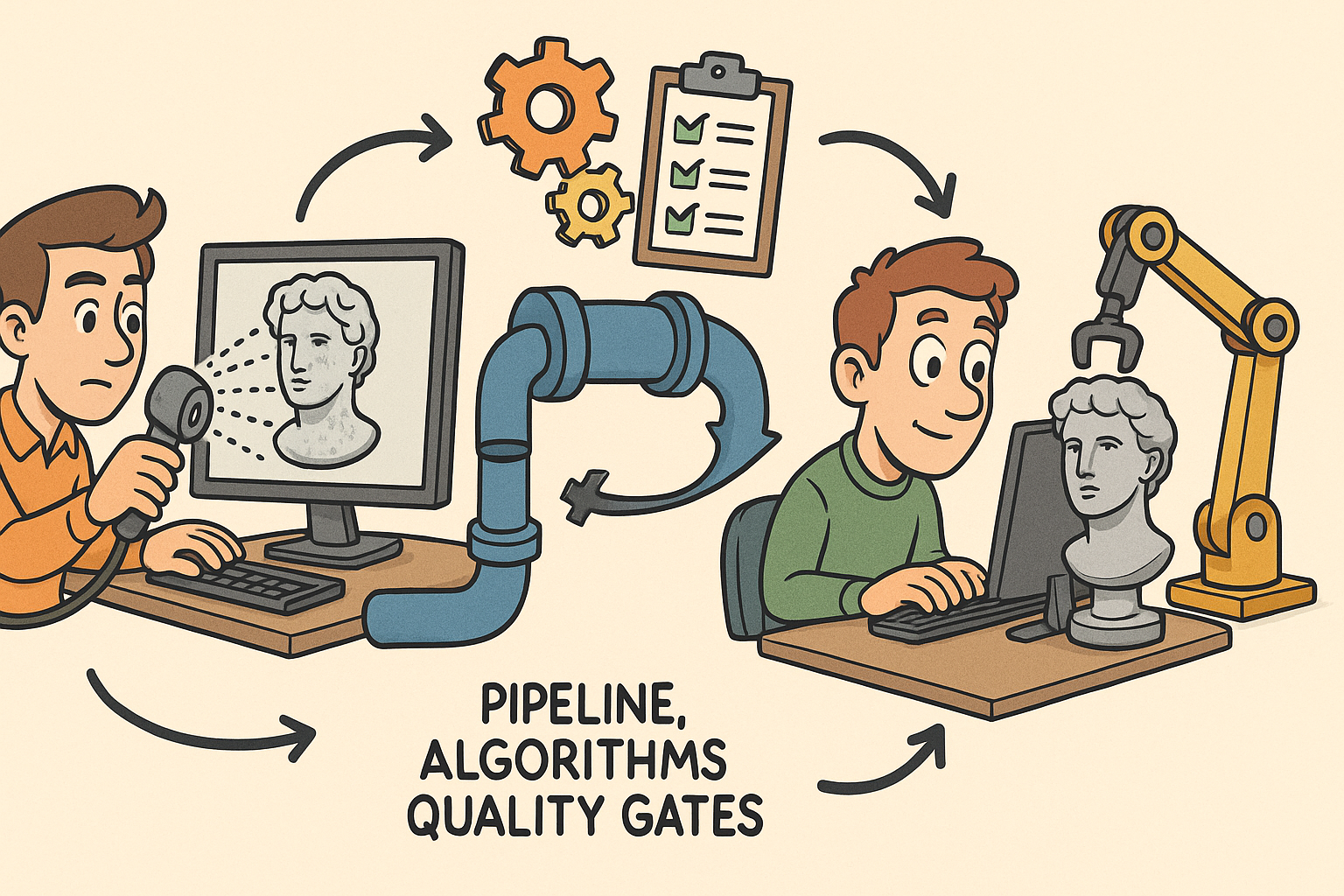Your Cart is Empty
Customer Testimonials
-
"Great customer service. The folks at Novedge were super helpful in navigating a somewhat complicated order including software upgrades and serial numbers in various stages of inactivity. They were friendly and helpful throughout the process.."
Ruben Ruckmark
"Quick & very helpful. We have been using Novedge for years and are very happy with their quick service when we need to make a purchase and excellent support resolving any issues."
Will Woodson
"Scott is the best. He reminds me about subscriptions dates, guides me in the correct direction for updates. He always responds promptly to me. He is literally the reason I continue to work with Novedge and will do so in the future."
Edward Mchugh
"Calvin Lok is “the man”. After my purchase of Sketchup 2021, he called me and provided step-by-step instructions to ease me through difficulties I was having with the setup of my new software."
Mike Borzage
Design Software History: Evolution of Design Software: From Isolated Workflows to Real-Time Collaborative Environments
August 09, 2025 14 min read


Early Isolated and Sequential Workflows
Foundations of Solitary Design
In the formative years of design software, workflows were typically executed in isolation with designers working one after the other rather than simultaneously. The development environment was characterized by sequential processes that dictated meticulous attention to detail before handing off designs for the next step. During this period, software applications operated almost entirely as standalone systems. Designers faced a significant barrier as interactivity was limited by the absence of effective sharing protocols. The design files were managed on local workstations, and collaboration among professionals was often sporadic and delayed by physical file transfers or face-to-face meetings. This approach was largely influenced by the limited processing power and storage capabilities of early computer hardware. In these early projects, emphasis was placed on individual craftsmanship and iteration. Because design software was in its infancy, most users were experts in their crafts who could work independently to ensure that every aspect of a design was correct before any external review took place.
Sequential Artistry and Early Conceptual Ideals
This isolated approach to design led to an environment where creativity was expressed through careful step-by-step refinement and serial documentation of development stages. Even though the workflows had a predictable pattern, the potential for integrating feedback from multiple participants was a notion that lingered on the horizon. Early discussions amongst engineers hinted at the possibility of multi-user capabilities and shared data repositories, yet such ideas were largely theoretical. There were lively exchanges in industry conferences about the potential benefits of a collaborative approach that would eventually lead to real-time collaboration. Several industry pioneers explored the advantages of synchronizing work across different geographic locations, although technological constraints often meant that these ideas remained in conceptual discussions. The isolation imposed by traditional processes eventually spurred innovators to consider dramatic improvements to how design data could be accessed and worked on in shared environments.
Hardware and Networking Limitations in Early Design
Constraints Imposed by Early Computer Hardware
The limitations imposed by early hardware systems made it difficult to implement any effective collaborative features in design software. Early computer systems were limited by their processing speeds, memory capacities, and the rudimentary nature of their networking capabilities. These constraints not only slowed down the computational performance of design applications but also impeded the incorporation of features that would allow for real-time shared workspaces within computer-aided design (CAD) environments. As designers attempted to push the boundaries of creativity within these confines, the lack of robustness in the underlying hardware forced a reliance on local, stand-alone modes of operation. The focus was on ensuring that the application performed reliably on the available machines, often at the cost of incorporating more advanced functionalities such as concurrent user operations. In this environment, IT departments and software developers prioritized stability and efficient use of scarce resources over the integration of collaborative features.
Networking Challenges and Early Interconnectivity Issues
Concurrently, networking technology was in a nascent stage and suffered from substantial bandwidth limitations and latency issues. The transformation of design software to support networked computing was hampered by the slow speeds and unreliable early data transmission protocols. The development of communication middleware and client-server frameworks was in its infancy, and even when experimental systems were tested, they rarely provided the reliability necessary for professional design environments. Discussions in technology symposiums during that era often emphasized the need for a stable and robust network infrastructure that could support simultaneous multi-user operations. The inherent difficulties of designing a system to work across intermittent network connections meant that the concept of a shared, real-time workspace was relegated to theoretical possibilities rather than practical implementations. The early limitations in both hardware and network connectivity created a definitive impact on how design software was structured and constrained the pace of collaborative innovation.
Conceptual Experiments on Shared Workspaces in CAD
Pioneering Ideas and Experimental Designs
During the early developmental phases of design software, bold ideas about enabling shared workspaces emerged from within research institutions and advanced design studios. Visionaries in computer-aided design began to explore the concept of linking different workstations to create a quasi-collaborative environment, even if practical implementations were years away from realization. Prominent researchers extended theories about multi-user editing and synchronized file sharing, pushing the envelope of what was possible within the constraints of available hardware and network latency. Discussions in academic journals and design symposia underscored the potential efficiency gains that could be realized if these systems could overcome their limitations. Despite the technological challenges, these pioneering experiments laid the groundwork for the eventual transformation toward true collaborative environments, setting the stage for the innovations that would follow in subsequent decades.
Early Theoretical Frameworks and Design Ideologies
Researchers and practitioners alike envisioned an ecosystem where design teams were not confined to isolated work environments but could simultaneously work on different facets of a single project. The isolated nature of early systems necessitated that any form of shared workspace had to be meticulously designed to ensure minimal disruption when synchronizing files and data. The theoretical frameworks developed during these early experiments often emphasized the case for simultaneous user access and explored preliminary methods for conflict resolution between overlapping edits. The conceptual arguments highlighted benefits such as reducing project turnaround times, enhancing creativity through immediate peer input, and facilitating better oversight of project developments. A bulleted list of some key ideas included:
- Simultaneous multi-user interaction
- Centralized data repositories
- Incremental improvement through immediate feedback
- Stronger integration between design stages
The Emergence of Networked Computing in Design Software
Integration of Networking with Design Applications
With the evolution of computing hardware and the gradual adoption of networked systems, design software began to integrate platforms capable of supporting remote connections and shared data access. The introduction of local area networks (LANs) in the corporate environment allowed the first steps toward interconnected design workstations. This breakthrough enabled designers to exchange files and collaborate asynchronously, paving the way for later enhancements. Software companies recognized the importance of connectivity and started embedding networking protocols into their solutions. The idea was to unlock the potential of digital communication channels that, although rudimentary by today’s standards, allowed data to be transmitted between machines. This transition was pivotal because it allowed for incremental integration of multiple user inputs. The rise of networked computing proved essential for laying the foundation of future collaborative platforms and informed the design of applications in many industries, ultimately fostering an environment ripe for the adoption of real-time collaboration.
Overcoming Limitations through Incremental Integration
As technology advanced, design software vendors began the gradual process of incorporating the benefits of networked infrastructure into their applications. This included adapting legacy systems to operate over local networks and begin integrating features such as file version control and collaborative project management. Developers experimented with early protocols that allowed simultaneous connections, even if the systems were only partially synchronized, as a proof of concept. In industries reliant on heavy computations, these incremental steps demonstrated the viability of sharing data across networked systems. The challenges of latency and data consistency were tackled with a combination of software optimizations and inventive approaches to resource management. Efforts were made to balance the need for speed with data integrity and user control. As a result, these formative experiments with networked computing ultimately contributed to the rich ecosystem of collaborative design tools that designers take for granted today.
Breakthroughs in Cloud-Based Platforms and Data Transmission Protocols
The Advent and Growth of Cloud-Based Technologies
The progression from isolated workstations to connected networks reached a significant turning point with the advent of cloud-based platforms. These platforms revolutionized the design software industry by providing centralized servers where data was stored and accessed over the internet. This monumental shift not only alleviated the challenges associated with limited local storage but also introduced a new paradigm where files and design iterations could be manipulated in near real-time. Early cloud services paved the way for rapid improvements in data management and sharing efficiencies. Software developers began to embed functionalities that supported simultaneous access by multiple users, laying an essential groundwork for true collaborative workflows. Consequently, the design industry witnessed a remarkable transformation in studio operations as architectural firms, product designers, and engineers rapidly embraced these revolutionary platforms. The movement toward cloud-based systems enabled the emergence of cloud-based platforms as a key enabler for real-time design collaboration and data synchronization.
Enhancements in Data Transmission and Protocol Efficiency
Alongside the evolution of cloud technologies, significant improvements in data transmission protocols facilitated a far more efficient exchange of design information. Innovators focused on reducing the delays inherent in transmitting large design files and complex data sets. Advances in broadband connectivity and the development of optimized file-sharing protocols contributed heavily to the growth of this sector. Key breakthroughs allowed compression algorithms to run faster without compromising data quality, and error correction methodologies were refined to maintain high data integrity. The combination of these advancements ensured that the latency issues which earlier hindered collaboration were mitigated. This ushered in a new age of uninterrupted, rapid communication between workstations, enabling designers to experience a fluid exchange of ideas across geographical boundaries. The progress made in data transmission protocols laid the technical groundwork for the modern era of design software, significantly enhancing the capabilities of remote and collaborative design practices.
Pioneering Real-Time Collaboration: Influential Companies and Innovations
Trailblazing Contributions from Industry Leaders
Several influential companies played a pivotal role in shifting design software from the confines of isolated systems to connected, collaborative environments. Giants in the field such as Autodesk and Dassault Systèmes were among the first to integrate collaborative elements into their product lines. They reimagined project workflows by incorporating features that allowed multiple users to view and edit designs simultaneously. The persistence of these early innovators laid the groundwork for what is now known as real-time collaboration. Their pioneering initiatives led to the development of proprietary network systems, innovative data sharing protocols, and user interfaces that prioritized collaborative interactions. Through persistent research and investment in networked computing infrastructure, these companies drove a significant evolution in design practices. Their groundbreaking innovations not only influenced subsequent software releases but also challenged the status quo of isolated design practices, thus igniting an industry-wide movement toward joint creativity.
Innovative Strategies and Technological Integration
These companies adopted a methodical approach to technological integration that focused on enhancing the user experience and ensuring data consistency across distributed systems. They developed strategies that balanced the demands of high-quality design output with the necessities of multi-user access. Key strategies included the implementation of version control, user permissions, and automated backups—all of which were critical for maintaining design integrity during simultaneous edits. Their pioneering work included experimental use of client-server models, and incremental software updates were rolled out to incorporate more robust connectivity tools. A bulleted list of some influential strategies included:
- Proprietary networking solutions tailored for design data
- Integrated version control systems
- Real-time synchronization of design files
- User-centric interface improvements
Transformation of Design Workflows through Real-Time Collaboration
Redefining the Design Process
As real-time collaboration features became more integrated into design software, profound changes in design workflows began to emerge. The ability for multiple team members to work on a project at the same time fundamentally redefined the traditional design sequential process. This transformation was characterized by a shift from a solitary, isolated environment to one that harnessed the power of collective creativity and immediate feedback. The integration of collaborative tools led to smoother transitions between the stages of ideation, prototyping, and final production. As a result, design teams experienced significant enhancements in efficiency, reduced time-to-market for products, and a higher overall quality of the creative output. The impact extended across numerous sectors—from architecture to mechanical engineering—where the legacy methods once dominated. Firms were now able to leverage design workflows that were deeply integrated with synchronous editing and real-time data sharing, resulting in a tangible boost in productivity and design accuracy.
Advantages of Simultaneous Multi-User Access
The rise of instantaneous collaboration also promoted a culture of continuous improvement and iterative refinement, where designers could swiftly incorporate feedback and explore creative variations without the usual delays associated with sequential processes. The collaborative environment introduced features such as live commenting, real-time updates, and enhanced version management, all fundamental in mitigating design errors and fostering teamwork. A bulleted list of the advantages realized includes:
- Accelerated design iteration cycles
- Enhanced interdisciplinary contributions
- Immediate conflict resolution through live feedback
- Improved accuracy via concurrent review processes
Industry Evolution: Architectural, Mechanical, and Product Design Impacts
Sector-Specific Improvements and Enhanced Productivity
The influence of collaborative design software has been markedly evident in industries such as architecture, mechanical engineering, and product design. The capability to work simultaneously on various aspects of a design project resulted in notable improvements, not only in the speed of project execution but also in the quality and integration of design elements. Teams that once operated under rigid, linear methodologies began to adopt a more flexible approach. Architectural design firms, for instance, witnessed dramatic reductions in project revision cycles, enabling architects to incorporate feedback from structural engineers, interior designers, and clients in real time. In the mechanical and product design domains, synchronized design sessions allowed for simultaneous prototyping and rapid iterations, which proved critical in today’s fast-paced market environment. These advancements fundamentally reshaped the competitive landscape, obliging even traditionally siloed industries to embrace the principles of flexible collaboration and shared expertise.
Collective Creativity and the Cross-Pollination of Ideas
Beyond mere process improvements, the introduction of collaborative software platforms catalyzed a cultural shift within organizations. Multidisciplinary teams found that the fusion of diverse perspectives led to innovative solutions that may not have been achieved through individual effort alone. The integration of live collaboration features nurtured a community of practice where sharing expertise and iterative peer feedback were valued above hierarchical processes. The resulting environment encouraged rapid prototyping and continuous innovation. Designers experienced a fundamental change in the dynamics of creative problem-solving. Some of the key impacts included:
- Enhanced ability to manage complex projects
- Transformation in design review cycles
- Greater interdisciplinary communication
- Accelerated decision-making processes
Enhanced Feedback Loops and Centralized Data Management in Modern Design
Centralized Repositories and Data Integrity
With the maturation of collaborative design software tools, one of the most celebrated advancements has been the establishment of centralized data management systems. These systems serve as the backbone for modern design environments by facilitating the secure storage, retrieval, and manipulation of project data. The implementation of rigorous version control protocols coupled with synchronized editing capabilities has not only improved data integrity but also maximized the efficiency of engineering workflows. This centralized approach has been instrumental in bridging the gap between team members working from different locations and time zones, ensuring that every update is meticulously recorded and accessible. The reorganization of vast databases into manageable, interconnected repositories allowed for improved consistency during the design process and provided designers with the confidence that their work was both secure and readily available for collective review.
Rapid Iteration and Effective Feedback Integration
Equally transformative has been the evolution of robust feedback loops within design software applications. The capability to integrate immediate feedback, whether through direct interface comments or automated alerts for design conflicts, has led to a refinement in the overall creative process. Designers now benefit from the ability to swiftly incorporate corrections and iterate on design elements in a unified platform. The use of automated notifications and change tracking has further enhanced the precision of collaborative efforts. Key advantages of this evolution include:
- Synchronized editing across various team members
- Rapid revision cycles with minimal disruptions
- Streamlined communication channels integrated within the design platform
- Enhanced control over version histories and data recovery
Recap of the Evolution from Isolated to Real-Time Collaborative Environments
Historical Progression and Key Technological Milestones
Reflecting upon the trajectory of design software evolution highlights an extraordinary journey from isolated, sequential systems to the sophisticated, real-time collaborative platforms that define modern practice. Initially, designers operated in a solitary environment, constrained by limited hardware capabilities and fragmented networking. Over decades, dedicated innovators and forward-thinking companies gradually dismantled these barriers, ushering in pivotal milestones such as the emergence of networked computing, the evolution of data transmission protocols, and the adoption of cloud-based platforms. This evolution was characterized by persistent experimentation and the eventual integration of multi-user functionality, all of which served as catalysts for transforming design environments. The widespread recognition of the benefits of real-time interaction laid the groundwork for a paradigm shift where creativity was no longer confined to isolated workstations but was amplified by the power of collective expertise. The cumulative effect of these milestones can be seen in the evolution of design processes, which now embody a seamless integration between creativity, technology, and operational efficiency.
Bridging the Past with Modern Collaborative Practices
The journey from early isolated design environments to interconnected systems is a testament to the resilience and ingenuity of the design community. Early challenges—notably hardware limitations and unreliable networks—presented daunting obstacles that were ultimately overcome through relentless innovation and commitment to progress. As design software matured, the integration of real-time collaborative features not only enhanced project efficiency but also transformed the very dynamics of how teams work together. This evolutionary path underscores the significance of continuous improvement and technological adaptation. It also demonstrates how early conceptual experiments set the stage for the comprehensive, user-centric, and integrated solutions available today. The transition to centralized, synchronized environments has redefined collaborative decision-making and has created a robust foundation that current and future generations of designers continue to build upon.
Reflections on Overcoming Challenges in Early Collaborative Designs
Struggles and Triumphs in the Face of Technological Barriers
Examining the evolution of collaborative design software reveals a narrative not only of technological progress but also of overcoming significant challenges. Early developers were frequently confronted with overwhelming obstacles that ranged from inefficient data transmission to the conceptual difficulties of synchronizing multiple simultaneous inputs. The struggle to achieve reliable real-time collaboration in the face of these limitations is a story marked by resilience, iterative improvement, and strategic innovation. Each step brought about creative solutions such as integrated version control systems, advanced protocol optimizations, and experimental networking tools that collectively paved the way for later successes. The initial frustrations and technical setbacks encountered in pioneering phases were transformed into definitive learning opportunities that enriched the industry’s understanding of collaboration mechanisms. This transformation ultimately led to a more empathetic and user-focused design approach that has defined modern collaborative practices.
Key Learnings and Legacy of Early Collaborative Efforts
The legacy of early collaborative initiatives is evident in the maturity of contemporary design software. These formative efforts taught the industry vital lessons in balancing system performance, security, and efficiency. The journey demonstrated the importance of maintaining robust security measures while simultaneously encouraging open channels for creative input and iterative feedback. A few of the key learnings included:
- The necessity of robust error correction in data transmission
- Importance of preserving data integrity during simultaneous edits
- Balancing hardware constraints with user interface design
- Fostering a collaborative culture even amidst technical limitations
Future Directions: Emerging Technologies in Collaborative Design Software
Vision for Next-Generation Collaborative Platforms
Looking forward, the field of design software is poised for further dramatic transformations as emerging technologies promise to redefine the boundaries of collaboration. With the rapid development of artificial intelligence, augmented reality, and next-generation networking protocols, the next wave of innovations is expected to take collaborative design experiences to previously unimagined heights. Future platforms are anticipated to leverage AI-powered tools to assist in real-time error detection, design optimization, and predictive analytics, all integrated seamlessly with existing cloud-based platforms and network infrastructures. Moreover, the advent of high-speed 5G and beyond is positioned to drastically reduce latency, thereby enhancing the responsiveness and fluidity of multi-user interactions. Innovations in secure blockchain technology may also contribute to maintaining data integrity and transparent version control, creating a comprehensive ecosystem that bridges creative concepts with technical rigor.
Adapting to an Era of Exponential Digital Growth
As the digital landscape continues to expand, design software developers are increasingly challenged to craft solutions that can keep pace with evolving user expectations. The expectation for instantaneous, global collaboration will likely drive further research into multi-user synchronization, robust cybersecurity measures, and the seamless integration of emerging communication paradigms. In this context, the industry is moving toward a model where the very act of design becomes more inclusive, adaptive, and intuitive. In anticipation of these changes, companies are investing in research and developing strategic partnerships that span disciplines and geographic boundaries. The outlook is one where creative potential is unbound by technological constraints, driving a new era of innovation and efficiency in design practices. This future-oriented vision underscores the continual evolution of collaborative systems and reaffirms the pivotal role that advanced technologies will play in shaping the next chapter of design software development.
Also in Design News

From Raw Scans to Manufacture-Ready Geometry: Pipeline, Algorithms, and Quality Gates
December 08, 2025 13 min read
Read More
Design Software History: Numerical Robustness in Geometry Kernels: History, Failure Modes, and Engineering Playbook
December 08, 2025 13 min read
Read More
Cinema 4D Tip: Reusable Cinema 4D Camera Rig Presets for Faster Shot Setup
December 08, 2025 2 min read
Read MoreSubscribe
Sign up to get the latest on sales, new releases and more …


